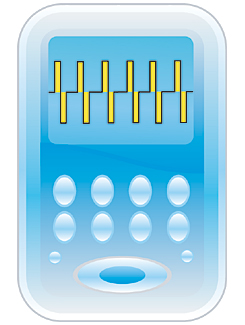
TENS
|
Tens
Transcutaneous Electrical Nerve Stimulation (TENS) is the stimulation, for analgesic purposes, which is applied by means of pulses which penetrate through to the peripheral nervous system via electrodes placed directly on the areas to be treated.
TENS stimulation is typically achieved by applying biphasic and symmetrical (square wave) currents with frequencies which can vary from 8 to 200 Hz. This type of analgesic stimulation, which fights pain without reverting to the use of pharmaceuticals, makes use of two different physiological mechanisms to obtain the following results:
1. Endogenous beta-endorphin and encephalon production due to the activation of the endorphin system by low frequency stimulation (< 8 Hz). This type of stimulation, which has a low insurgence factor, produces a generalised analgesic effect.
2. The production of serotonin and the blockage of pain signals (gate control) headed in the direction of the central nervous system. Higher frequency levels of stimulus are applied in this case (starting from 80 Hz). The serotonin and “gate control” mechanism have a very rapid analgesic effect, but is of short duration.
APPLICATION METHOD
TENS, which uses a biphasic symmetric compensated current, has two different applications:
- segmented sensitivity inhibition against acute localised pain
- liberation of endorphins for the treatment of chronic and diffuse pain.
ANALGESIC EFFECT FOR SEGMENTED SENSITIVITY INHIBITION
In the human body there are two types of afferent nervous fibres, meaning fibres which transmit peripheral information to the encephalic part of the brain. The first type are wide diameter fibres, called A-Beta fibres, which are responsible for transmitting tactile sensitivity information from the peripheral to the central nervous system. The second type, called A-Delta fibres, have a smaller diameter and transmit pain sensations to the encephalic part of the brain. Another factor differentiating these two types of fibre is the fact that the first has a low excitement level, while the second shows a much higher excitement threshold. Along the path which conducts the pain signal from the periphery to the centre there is, in spinal marrow, an interneuron inhibitor which serves as a selector of the signal.
The TENS current, as it stimulates the wide diameter A-Beta fibres, excites the interneuron inhibitor. Its activation, or excitement, which impedes pain signals from reaching the encephalic part of the brain, blocks the transmission of pain.
This mechanism has been called, by Melzack and Wall who were the first to identify this phenomenon in 1965, “gate effect” or “Gate control”.
figure 1.
In this mode TENS stimulation current impulses should be of short duration (< 1 msec) with a frequency from 80 to 150 Hz. The intensity should be comfortable (non painful) and produce only a slight tingling sensation (tactile sensitivity threshold). In order to be efficacious the treatment should last at least 30 minutes.
ANALGESIC ACTION FOR THE LIBERATION OF ENDORPHINES
Endorphins and encephalines are proteins produced in the brain, have functions similar to those of morphine and are present in various parts of the central nervous system. For this reason they are particularly efficient in the sedation of pain.
These endogenous morphines are the body’s natural analgesic neuro mediators and can affix reticulated tissue on cellular structures, such as the thalamus, producing a sedative effect which can be compared to morphine.
Electro stimulation with TENS currents can stimulate the liberation of these morphine-like endogen substances.
Research has, in fact, shown that 30 minute treatment sessions with low frequency currents of high intensity able to produce rhythmic muscular shocks near to the pain threshold can increase the levels of endorphins by 20% over normal level. This increase in endorphin levels is maintained for 30 minutes after the end of the treatment.
|



